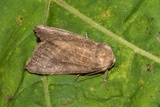Hydraecia petasitis Doubleday, 1847 Species
Last modified: Nov. 19, 2025, 1:54 p.m.
This is a rare and very local, but possibly overlooked species, mainly known from the Scheldt and Durme valleys in Flandres.
This species is considered Near Threatened according to the IUCN Red List category for Flanders 2023.
Details
- Classification
- Family: Noctuidae > Subfamily: Xyleninae > Tribus: Apameini > Genus: Hydraecia > Species: Hydraecia petasitis
- Vernacular names
- Groot-hoefbladboorder (NL), Butterbur (EN), La Noctuelle du Grand-Taconnet (FR), Pestwurzeule (DE)
- First mention in Belgium
- Van Schepdael J. 1958a. Lépidoptères nouveaux pour la faune belge. — Linneana belgica 1: 3–4. On page 3.
- Status
-
Native
Distribution
Bionomics
The larvae feed from April to early July in the stem and later in the roots of the host plant. Infected flowering stems often wilt at the top and droop. When feeding on Petasites hybridus, larvae of Clepsis spectrana can also cause wilting of flowering stems, so the larva should be checked in any case. The adults come to light in very small numbers.
Flight periods
The adults are on the wing in August and early September, always in the immediate surroundings of the foodplant.
Habitat
The species is dependent upon the nearby presence of its food plant.















